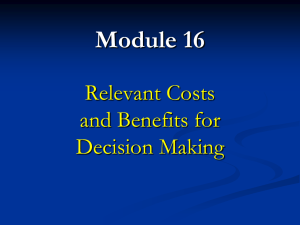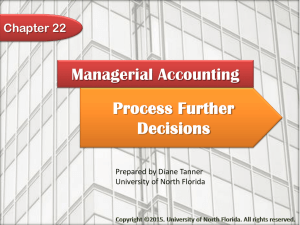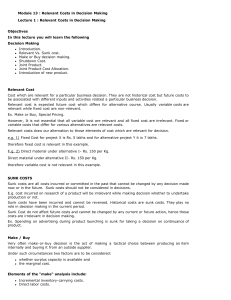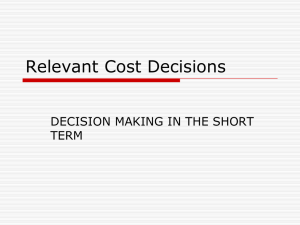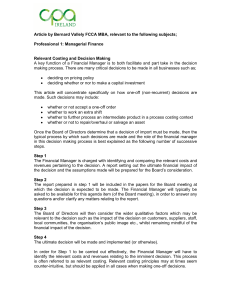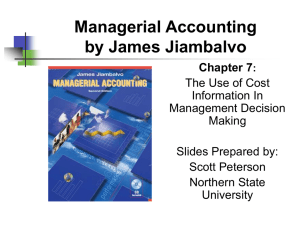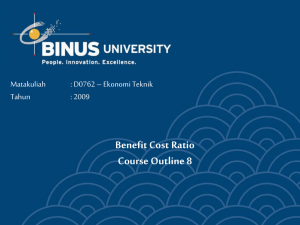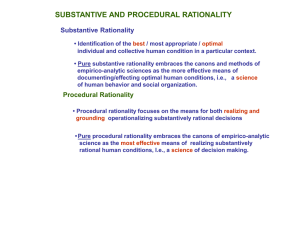Relevant analysis
advertisement
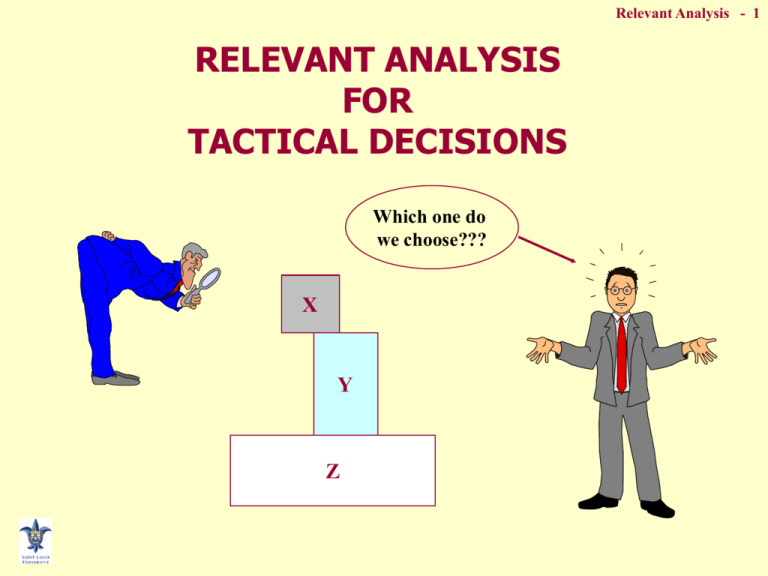
Relevant Analysis - 1 RELEVANT ANALYSIS FOR TACTICAL DECISIONS Which one do we choose??? X Y Z Relevant Analysis - 2 RELEVANT ANALYSIS Relevant items – Items (either revenues or costs) that DIFFER across alternatives – Items relating to FUTURE courses of action Irrelevant – Past items (“sunk costs”) – Future items that DO NOT differ across alternatives Relevant Analysis - 3 SUNK COSTS Costs of resources that have already been committed, and regardless of what decision is made by managers, cannot be changed. These costs are irrelevant in decision making. Significance of historical costs – Basis for determining cost behavior – Tax implications Relevant Analysis - 4 EXAMPLES OF RELEVANT COSTS AND REVENUES Cost increases & cash outflows Down payment on a new machine Monthly lease payments on a new machine Cash savings and cash inflows Disposal of old machine Monthly cost savings – Materials – Labor – Overhead Relevant Analysis - 5 OPPORTUNITY COST The potential benefit sacrificed when, in selecting one alternative, another alternative is given up Relevant Analysis - 6 RELEVANT ANALYSIS MODEL Recognize and define problem Identify feasible alternatives Identify relevant items Total relevant costs and benefits for each alternative Assess qualitative factors Select alternative with greatest overall benefit Relevant Analysis - 7 RELEVANT ANALYSIS & CONTRIBUTION ANALYSIS Contribution analysis is normal first step in relevant analysis Cost behavior and relevance are NOT identical Relevant Analysis - 8 ADDITIONAL CONSIDERATIONS When determining “costs,” what costs are relevant? – All? – Only short-term variable? How flexible are the capacities of the firm’s resources? Relevant Analysis - 9 TACTICAL DECISIONS Make or Buy (Outsourcing) Retain or Drop Product Lines Special Orders Sell or Process Further Changes in Product Mix Relevant Analysis - 10 SPECIAL ORDERS Decision Rule Special orders that do not involve a long-term contract should be priced in relationship to available capacity Relevant Analysis - 11 AVAILABLE SURPLUS CAPACITY Decision Rule When capacity is available, incremental revenues have to be greater than incremental costs Relevant Analysis - 12 DECISION RULE OPPORTUNITY COSTS The alternative that has the greatest contribution margin per unit of constrained resource should be selected, thereby minimizing the opportunity cost Relevant Analysis - 13 NO AVAILABLE CAPACITY Decision Considerations Additional capacity may be acquired through: – Overtime operations – Subcontracting Which result in additional costs When capacity is not available, incremental revenues have to be greater than incremental costs Relevant Analysis - 14 A Decision to Sell or Process Further Product A Joint Input Joint Costs Should the company process further? Product B Split-off point Separate Processing Joint products Separate Processing Relevant Analysis - 15 Implications of Relevant Analysis • Short-term vs. Long-term January 1996 January 1996 • Quantitative vs. Qualitative January 1996 January 1996 January 1996 January 1996 January 1996 • Data probability Sat Fri Thu Wed 6 5 4 3 13 12 11 10 20 19 18 17 27 26 25 January 1996 24 Tue 2 9 Mon Sun 1 8 7 16 15 14 23 22 21 30 29 28 January 1996 January 1996 January 1996 31 January 1996 January 1996 January 1996



